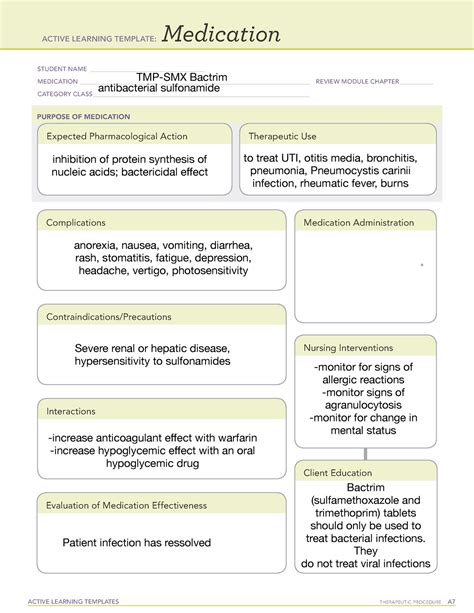Intro
Discover Bactrim antibiotic drug, a sulfonamide-based medication treating bacterial infections, with uses, side effects, and interactions, including urinary tract infections and respiratory issues.
The use of antibiotics has become a cornerstone in the treatment of various bacterial infections. Among the numerous antibiotics available, Bactrim has emerged as a widely prescribed medication due to its effectiveness against a broad spectrum of bacterial infections. Understanding the intricacies of Bactrim, its mechanisms, benefits, and potential side effects is crucial for both healthcare professionals and patients alike. This article aims to delve into the world of Bactrim, exploring its composition, applications, and the importance of responsible antibiotic use.
Bactrim, also known by its generic name sulfamethoxazole/trimethoprim, is a combination antibiotic consisting of two active ingredients: sulfamethoxazole and trimethoprim. These components work synergistically to inhibit the growth of bacteria by interfering with the production of folic acid, a crucial nutrient for bacterial replication. The sulfamethoxazole component competes with para-aminobenzoic acid (PABA), a substrate used by bacteria to produce folic acid, while trimethoprim inhibits the enzyme dihydrofolate reductase, further blocking the conversion of folic acid into its more active form, tetrahydrofolic acid. This dual mechanism of action makes Bactrim particularly effective against a wide range of bacterial infections.
The applications of Bactrim are diverse, treating various infections including urinary tract infections (UTIs), respiratory tract infections, skin and soft tissue infections, and gastrointestinal infections, among others. Its effectiveness against both gram-positive and gram-negative bacteria makes it a versatile option for healthcare providers. Moreover, Bactrim is often prescribed for the treatment of infections in individuals with compromised immune systems, such as those with HIV/AIDS, due to its broad-spectrum activity.
Bactrim Composition and Mechanism

The composition of Bactrim, being a combination of sulfamethoxazole and trimethoprim, offers a potent synergy that enhances its bacteriostatic effects. By understanding the mechanism through which Bactrim acts, healthcare professionals can better appreciate its role in treating bacterial infections. The bacteriostatic action of Bactrim means that it inhibits the growth and multiplication of bacteria, giving the body's immune system an opportunity to eliminate the infection. This is particularly beneficial in the treatment of chronic or recurrent infections where the goal is not only to eliminate the current infection but also to prevent future occurrences.
Benefits of Bactrim
The benefits of Bactrim are multifaceted. Its broad-spectrum activity makes it an effective treatment option for a variety of infections. Additionally, Bactrim is generally well-tolerated, with most patients experiencing minimal side effects. The oral formulation of Bactrim also enhances patient compliance, as it is easier to administer compared to intravenous antibiotics. Furthermore, the cost-effectiveness of Bactrim, especially when compared to newer, more specialized antibiotics, makes it an attractive option for both healthcare providers and patients.Applications and Uses of Bactrim

Bactrim's applications span across various medical specialties, including urology, respiratory medicine, dermatology, and gastroenterology. In urology, Bactrim is commonly used to treat UTIs, including acute uncomplicated cystitis and pyelonephritis. In respiratory medicine, it is used for the treatment of community-acquired pneumonia and other respiratory tract infections. Dermatologists prescribe Bactrim for skin and soft tissue infections, while gastroenterologists may use it for the treatment of certain gastrointestinal infections.
Side Effects and Precautions
While Bactrim is generally well-tolerated, it is not devoid of side effects. Common side effects include nausea, vomiting, and allergic reactions such as rash and itching. More severe side effects, although rare, can include Stevens-Johnson syndrome, a severe skin and mucous membrane disorder, and agranulocytosis, a potentially life-threatening reduction in white blood cells. Patients with a history of allergy to sulfonamides or trimethoprim should avoid Bactrim, and those with kidney or liver dysfunction should use it with caution due to the potential for increased toxicity.Responsible Use of Bactrim

The responsible use of Bactrim and other antibiotics is crucial to prevent the development of antibiotic resistance. Overuse or misuse of antibiotics can lead to the selection and proliferation of resistant bacterial strains, rendering these medications less effective. Healthcare providers should prescribe Bactrim judiciously, ensuring that the benefits of treatment outweigh the risks. Patients also play a critical role by adhering to the prescribed treatment regimen, completing the full course of antibiotics as directed, and not sharing or saving antibiotics for future use.
Antibiotic Resistance and Bactrim
The issue of antibiotic resistance is a growing concern globally, with significant implications for public health. The overuse and misuse of antibiotics, including Bactrim, have contributed to the emergence of resistant bacterial strains. To combat this, strategies such as antibiotic stewardship programs have been implemented in healthcare settings to promote the appropriate use of antibiotics. Additionally, research into new antimicrobial agents and alternative treatments, such as bacteriophage therapy, is ongoing to address the challenge of antibiotic resistance.Practical Considerations for Patients

For patients prescribed Bactrim, several practical considerations can enhance the treatment experience. Taking Bactrim with a full glass of water and maintaining adequate hydration can help prevent kidney stones, a potential side effect. Patients should also be aware of the signs of allergic reactions and seek medical attention immediately if they experience any severe symptoms. Furthermore, completing the full course of Bactrim as prescribed, even if symptoms improve before finishing the medication, is crucial to ensure the infection is fully cleared and to prevent the development of resistance.
Dosage and Administration
The dosage and administration of Bactrim vary depending on the infection being treated and the patient's age, weight, and renal function. Typically, Bactrim is administered orally, with dosages ranging from 800 mg/160 mg to 1600 mg/320 mg of sulfamethoxazole/trimethoprim per day, divided into two or more doses. For pediatric patients, the dosage is adjusted based on body surface area or weight. It is essential for patients to follow the dosage instructions provided by their healthcare provider to ensure effective treatment and minimize the risk of side effects.Conclusion and Future Perspectives

In conclusion, Bactrim remains a valuable antibiotic in the treatment of various bacterial infections. Its broad-spectrum activity, combined with its generally favorable safety profile, makes it a preferred option for many healthcare providers. However, the issue of antibiotic resistance necessitates the responsible use of Bactrim and other antibiotics. Future perspectives include the development of new antimicrobial agents and the implementation of strategies to combat antibiotic resistance, ensuring that effective treatments remain available for generations to come.
Final Thoughts
As the medical community continues to navigate the complexities of bacterial infections and antibiotic resistance, the role of Bactrim and similar medications will remain critical. By promoting the judicious use of antibiotics, supporting research into new treatments, and educating patients about the importance of adherence to treatment regimens, we can work towards a future where bacterial infections can be effectively managed without the looming threat of widespread antibiotic resistance.What is Bactrim used for?
+Bactrim is used to treat various bacterial infections, including urinary tract infections, respiratory tract infections, skin and soft tissue infections, and gastrointestinal infections.
How does Bactrim work?
+Bactrim works by inhibiting the growth of bacteria through a dual mechanism of action, involving the inhibition of folic acid production, which is essential for bacterial replication.
What are the common side effects of Bactrim?
+Common side effects of Bactrim include nausea, vomiting, and allergic reactions such as rash and itching. More severe but rare side effects can include Stevens-Johnson syndrome and agranulocytosis.
We invite readers to share their thoughts and experiences with Bactrim and its uses in the comments below. Your insights can help foster a more informed discussion about the role of antibiotics in modern medicine and the challenges posed by antibiotic resistance. Additionally, consider sharing this article with others who may benefit from a deeper understanding of Bactrim and responsible antibiotic use, contributing to a broader conversation about public health and the importance of preserving the efficacy of our current antimicrobial arsenal.
